
Introduction
In the global fashion industry, leather remains a symbol of luxury, durability, and style. While traditional markets such as Europe and North America have long dominated the leather industry, emerging markets in Asia and Africa are rapidly gaining attention. These regions are becoming major players in the production, consumption, and export of leather fashion, driving innovation and reshaping the industry. In this blog, we’ll explore the factors behind the growth of leather fashion in Asia and Africa and how they are influencing global trends.
1. Asia’s Growing Leather Industry
Asia has experienced significant growth in its leather industry, fueled by a combination of rising incomes, increasing demand for premium fashion, and a large manufacturing base. Countries like India, China, and Bangladesh are key players in both production and consumption.
Pakistan’s Leather Renaissance
Pakistan is one of the largest leather producers in the world, with a rich history in leather craftsmanship. In recent years, Pakistani brands have begun to merge traditional craftsmanship with modern fashion sensibilities, creating unique leather products that appeal to both local and global markets. Cities like Sialkot and Karachi are leather hubs, producing everything from luxury handbags to leather jackets and shoes.
China’s Leather Manufacturing Powerhouse
China has long been known for its large-scale leather manufacturing. While it is primarily known for production, the country is now seeing an increasing demand for high-end leather fashion, driven by a growing middle class. Chinese consumers are gravitating toward premium leather products, fueling both domestic brands and international companies to cater to this expanding market.
Bangladesh’s Competitive Advantage
Bangladesh has also emerged as a major exporter of leather goods, especially footwear. With its competitive pricing and growing infrastructure, the country is becoming a leading supplier to European and American markets. Many global fashion brands have shifted production to Bangladesh, taking advantage of its cost-effectiveness and skilled labor force.
2. Africa’s Rise in the Leather Market

Africa is home to some of the world’s most valuable leather resources, particularly in countries like Ethiopia, Kenya, and South Africa. The continent’s leather industry has seen a resurgence in recent years, driven by local entrepreneurship, government support, and a growing appetite for fashion that blends tradition with modernity.
Ethiopia: A Leather Powerhouse
Ethiopia is renowned for its high-quality leather, particularly from the sheepskin and goatskin of its livestock. The country’s government has made significant investments in the leather sector, with a focus on value addition and exporting finished leather goods, including shoes, handbags, and jackets. Ethiopian leather products are gaining recognition for their durability, craftsmanship, and sustainability, making them a rising force in global leather fashion.
Kenya: A Hub for Leather Craftsmanship
Kenya’s leather industry has also seen impressive growth, with a particular emphasis on handmade leather goods. Kenyan artisans are known for their intricate craftsmanship, producing leather items that are both stylish and unique. Leather products like bags, belts, and sandals from Kenya are becoming popular in global markets, thanks to their authentic designs and ethical production practices.
South Africa: Blending Fashion and Tradition
South Africa’s leather fashion industry is growing as local designers increasingly blend traditional African aesthetics with contemporary styles. From high-fashion leather jackets to accessories, South Africa is positioning itself as a leader in luxury leather goods within the continent.
3. Sustainability: A Key Driver in Emerging Markets
One of the notable trends in both Asia and Africa is the focus on sustainability. As consumers become more conscious of ethical fashion, leather manufacturers in these regions are adopting eco-friendly practices. In India, there is a growing focus on vegetable-tanned leather, which uses natural tannins instead of harmful chemicals. Similarly, in Ethiopia, many leather producers are emphasizing sustainable sourcing and processing methods, creating environmentally friendly leather products that appeal to global buyers.
4. Challenges and Opportunities
Despite the growth, emerging markets in Asia and Africa face challenges such as infrastructure gaps, fluctuating raw material prices, and environmental concerns. However, the opportunities for expansion are immense. With increasing investments in technology and innovation, these regions are well-positioned to become global leaders in leather fashion.
Conclusion
The leather fashion industry is undergoing a significant transformation, with emerging markets in Asia and Africa at the forefront. As these regions continue to develop their leather industries, they are not only influencing global fashion trends but also setting new standards in sustainability and craftsmanship. Whether it’s the sleek leather jackets from South Africa or the premium leather accessories from India, the future of leather fashion is brighter than ever.